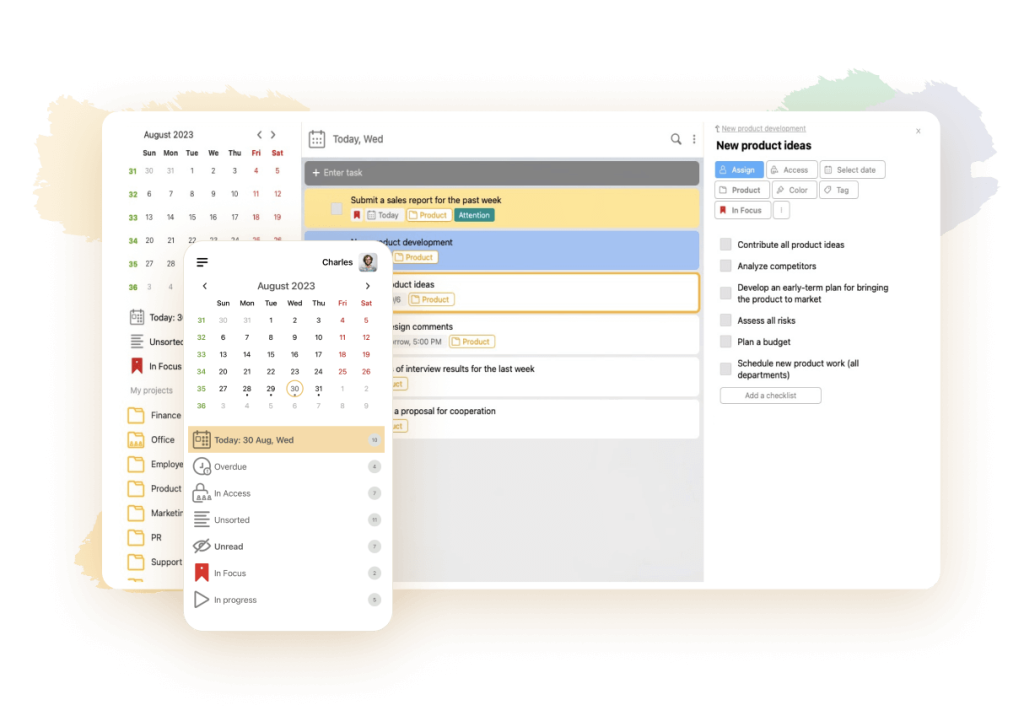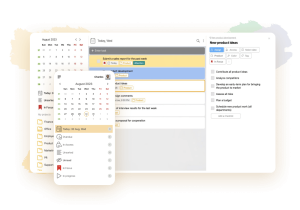Scrum for project management

The Scrum management methodology, developed by programmers Jeff Sutherland and Ken Schwaber, has revolutionized the project management environment. Initially, it was applied in the IT sphere, in software code development. Nowadays, the revolutionary Scrum technology is actively used in many manufacturing and non-profit industries where collaborative work is required.
Scrum was first described in the world by Hirotaka Takeuchi and Ikujiro Nonaka of the Japanese company Toyota in 1986. In their article published in the Harvard Business Review, they noted that the best results in projects are achieved by small teams made up of specialists from different fields. This phenomenon was called Scrum, borrowed from sports terms. In rugby, this expression is usually used to describe “capturing the ball by coordinated interaction within the team and then running it down the field”. Scrum is an ideal model of relationships in a working group.
Agile and Scrum: connection and differences
Some sources mistakenly confuse the principle of Scrum process organization with Agile methodology. Despite the similarity of the wording of these concepts, they have significant key differences. Agile is a common set of principles and values that are realized by applying flexible approaches to work on projects. Agile at its core consists of the four values described in the Manifesto:
- People, their interaction with each other is more important than tools.
- The product that works is more important than the documentation that accompanies it.
- Cooperation with the customer is more important than agreeing on the terms of the contract.
- The willingness to change quickly is more important than following the plan.
The Agile philosophy is based on twelve principles:
- Customer satisfaction is a priority. The main thing is that the client is satisfied. Therefore, the team regularly provides him with interim results of work without waiting for the final project.
- Changes in requirements are allowed at all stages of development.
- A workable product should come out as often as possible.
- Constant collaboration between performers and customers.
- Engaging a team of professionals to work on the project.
- Lively communication within the team.
- The goal of the workflow is a fully working product.
- Sustained pace of work.
- Improvement of the project at all its stages.
- Minimal extra work.
- Self-organizing teams.
- Striving to continually improve your performance.
It turns out that the difference is that the Scrum framework is one of the approaches of the Agile family, used to implement its principles in a practical environment.
What is Scrum
Project managers are well aware of how difficult it is to organize teamwork. Lack of mutual understanding in a team leads to constant disagreements, disputes, and conflicts between participants. As a result, employees in the team working on a common process move in opposite directions. This is followed by missed deadlines, increased project costs, and customer dissatisfaction with the quality of work performed.
The Scrum methodology, according to its creators, is able to prevent these problems. This practice is the opposite of the classical step-by-step approach used in management. The Scrum method is based on constant learning, adaptation to changes, and does not require the introduction of expensive tools. Its main characteristics are customer focus and flexibility. A Scrum team involved in a project should meet the following criteria:
- to constantly improve;
- Be able to self-organize and work autonomously;
- be multifunctional by involving specialists of different qualifications and levels.
The main focus when selecting teams is on their multifunctionality. This eliminates the need for interaction between departments. All the necessary specialists: marketers, developers, designers, are already present in the team. Therefore, any issues arising in the course of work on the process are resolved through personal communication, saving time for creating and signing documents. In parallel, the team receives feedback from the customer, which allows it to confidently move along the planned path and get quality results.
The work process in a scrum team consists of short cycles with constant changes in established priorities. This way of organization is conducive to constant self-development, improvement of skills of team members.
In contrast to the traditional approach of organizing processes based on predictability and controllability, making plans, diagrams, tables, which do not always work, the agile Scrum method allows you to get the desired result in short time cycles (sprints) with less effort.

Scrum terminology: roles, tools, team
According to this approach, work processes are divided into short time periods – sprints, during which the Scrum team needs to complete a given amount of work. The standard duration of a sprint is 30 days.
The group consists of:
- Developers. 5-6 specialists creating a product, working together in a unified bundle. Each participant has his own skills and experience. Working together, colleagues train each other to perform certain tasks to achieve the planned result. Plan work within a sprint, assess their capabilities based on previously completed sprints.
- Product Owner (customer or his official representative). Its functions: consulting, coordination of developers’ work. The product owner compiles backlogs. Give instructions to developers on priority, frequency of tasks to be performed. Decide when the product is ready for delivery to the customer.
- Master. Куратор, помогающий наладить отношения в группе. Главная задача scrum менеджера – организовать процесс так, чтобы его участники могли работать самостоятельно. От того, насколько он разбирается в тонкостях процесса, насколько хорошо знает Scrum-команду, зависит успех проекта.
The following tools (artifacts) are used to implement the project objectives:
- A product backlog or task list. It is maintained by the product owner. He prioritizes tasks by assigning them sequential numbers from 1 to 5 or more. He adds new tasks or removes irrelevant ones from the list, adapting them to market changes. Developers estimate the cost of each requirement, modifies the list accordingly. Backlog must be compiled and submitted by the deadline. Otherwise, it will not be possible to complete the project by the specified deadline.
- Sprint backlog (custom task list or log). It is compiled at planning meetings. Can be fixed or interactive. Tasks are broken down into smaller subtasks, lasting from 2 to 3 days, to make them easier to work on. Sprint log is compared to the task list. It is evaluated by the developers. The product owner should make sure that there are no small or insignificant tasks in the list that distract the time of employees and do not affect the progress of the project.
- Sprint Graph. Displays the daily amount of work remaining until the end of the deadline. It is used to analyze the current situation, to make timely changes to the project. Tracking the schedule, you can see any deviations. If the scope of work does not change, it means that the Scrum team is having some difficulties in completing the tasks.
- Incremental (sprint goals). Each organization defines product readiness differently based on the specifics of the process. It can be a full version, a checkpoint, or an epic.
There are three types of practices present in the management of scrum:
- daily meetings;
- sprint review meetings;
- emergency stop;
- retrospective.
Daily meetings of about 15 minutes are held in the morning. They are organized by the Scrum master. During the daily meetings, it is found out what the developers are doing at the moment, what difficulties they are experiencing. Sprint review meetings take place at the end of the sprints. Their purpose: to analyze the completed work, to assess compliance with the set goals. Emergency stops are practiced in exceptional cases, if it is impossible to achieve the desired results.
A retrospective is necessary to discuss the successes and failures of the project participants. Its purpose is to create conditions for avoiding difficulties next time, without dwelling on problems and failures.

How the method works in practice
A brief diagram of the framework is as follows:
- Select the “Product Owner”, the person who has an idea of what the final product should be.
- Assemble a team consisting of specialists who will perform the work on the project. It includes specialists of different profiles with sufficient qualifications and skills.
- Assign a foreman to coordinate workflow, organize meetings, and help colleagues overcome obstacles to a common goal.
- A “Backlog” is a list of all project tasks arranged in order of urgency. It is modified and amended throughout the life of the project.
- Workgroup members rank all items in the plan by cost and complexity, scoring them accordingly.
- The first meeting is held, at which a sprint of no more than 4 weeks is planned. During the sprint, participants complete their assigned tasks and receive points for doing so. Each team should strive to increase the number of points in subsequent sprints in relation to previous sprints.
- For visual information on the project, participants keep a whiteboard divided into three columns: “blacklog or to do”, “in progress”, “completed”. Stickers are glued to the board, moving through the columns as tasks are completed.
- The results of the work done are discussed at daily meetings. They are short, about 15 minutes. During the meetings questions are raised: “What did you do yesterday?”, “What do you plan to do today?”, “What problems prevent you from doing your work?”.
- At the end of the sprint, a sprint review is organized to clarify what has been done on the project during this period.
- After handing in the results, an organizational meeting is held to select methods to improve the project work. It is discussed what has been done and what will be done next.
A sprint is considered completed if the team has submitted a finished product by the deadline. The team starts the next sprint provided that the customer is satisfied with the results of the work and accepts them without modifications. If for some reason it is not possible to achieve the goal within a certain time frame, the Product Owner is notified, who reallocates the deadlines for the project. If the work is completed ahead of schedule, additional goals can be added to the remaining time.
Rules and restrictions
There is a certain set of rules that add efficiency to the framework:
- The group has a strictly defined number of members: Product owner, master and developers.
- All sprints are the same in duration.
- The next sprint starts as soon as the current sprint is completed.
- All sprints start with planning. Every morning starts with a short meeting.
- Each sprint concludes with a review to get feedback from the customer representative.
- Sprint backlogs are supplemented during the course of the work in case of emergency.
Restrictions:
- For a project to be successful, the people involved in it must be interested in getting a quality result. If they are not ready to cooperate, the project is doomed to failure.
- The framework is difficult to implement in large companies. For this purpose, special scaling frameworks are used, such as LeSS, SAFe, Nexus, and others.
For the structure to work properly, all team members must work with full commitment. If one of them leaves in the middle of a project, it will have a negative impact on the overall results.
Difference from Kanban
The popular Kanban methodology belongs to the Agile philosophy. The difference between these techniques is in the approach to organizing work processes. The goal of Kanban is to provide all team members with the same amount of work. Situations where some employees are overloaded and the remaining members do not know what to do are not allowed.
Organization of the workflow according to Scrum implies its clear division into separate sections, streams, during which it is necessary to perform a certain amount of work. In Kanban, new tasks can be added to the team members at any time.
In the first case, work groups are time-oriented, while in the second case, they are constantly performing tasks non-stop. When using Kanban, achievements are recorded on whiteboards. They visually display the progress and degree of task completion. In Scrum, achievements are evaluated at the end of sprints.

Advantages and disadvantages of Scrum
This method of organization is suitable for creating new products. With its help it is easier to organize interaction between employees of different departments of the company. The method is characterized by simplicity and does not require expensive resources. It is not difficult to understand the roles, artifacts and activities. It structures the workflow, leaving the freedom to make company-specific decisions. Other advantages of Scrum methodology:
- Quick adaptation to changing requirements, in accordance with the wishes and needs of the client. Companies working according to this methodology are able to complete any job in the shortest possible time.
- Ease of mastering. It does not take much time to master the work.
- Getting working versions of the product after each sprint (by using an iterative management principle with separate goals in each iteration).
- Emphasize a cross-functional team that can work independently without additional coordination from management.
- High motivation of employees due to frequent product launches. When introducing a new product, the company sees the results of its work and realizes that the efforts were not wasted. This gives new strength for further improvement of the product.
- Reduced development costs.
- Customer interest, taking an active part in the process, watching the product improve over a short period of time.
- Fast income due to quick delivery of work to customers.
There are disadvantages as well. These are:
- Rigid rules of interaction that may cause some inconvenience to the customer.
- Lack of a plan to respond to risks arising during project implementation.
- Additional costs for recruiting suitable staff and motivating them.
In the long term, these disadvantages are completely offset. Application of Scrum technologies in companies of different levels helps to realize various projects, increasing their competitiveness and profitability.
In what cases is it used
Scrum was initially used in software companies. The first project working on the principles of this management principle was software for a network of ATMs. Currently, IT companies remain the main consumers of this product. Although developers claim that scrum methods are universal and suitable for solving a variety of tasks in different spheres of production, including construction, manufacturing, education or politics.
Frameworks has been actively implemented in various business processes since the 1990s. It is used for:
- product development, product enhancements;
- constant release, daily product updates;
- market research;
- testing new technologies;
- determining the capabilities of the released product.
An example of an effective use of Scrum is an e-mail newsletter. In this case, the team will include: a marketer, a copywriter, an editor, a designer and a layout designer. The role of the “product owner” is assigned to the e-mail marketer, and the functions of the Scrum-master, if the appropriate knowledge and skills are available, can be performed by the editor. The development process is divided into sprints:
- Development, launch of e-mail newsletters.
- Finalize written messages with consumer response in mind.
- Work on improving conversions.
At the end of each sprint, a finished product will be presented in the form of a newsletter, fully ready for launch. At the same time, the source material is constantly being improved: adjustments are made to the texts of letters, various elements included in the newsletter are added or removed. The final goal of the project is an effective newsletter with high conversion rates.
Scrum methodology is well suited for business areas related to the creation, production of complex products, working in unstable, changing conditions. The principles of this way of organizing processes are also convenient to use in any teamwork. That is why Scrum is popular in many spheres.
When Scrum methodology does not work
Despite its flexibility and versatility, the Scrum framework is not suitable for all companies. Scrum should not be used for current operational activities. Scrum is a way of organizing work on projects. In order for Scrum to work, it is necessary to follow its rules precisely and completely, as described in the guide.
The main driving force in Scrum is cross-functional, self-organizing teams. They are able to work independently, and are determined to achieve a positive result in a short time. But, according to sociological observations, the total number of such employees capable of self-motivation is no more than 15% of the total number of able-bodied personnel. That is, a very small part of employees can work effectively in Scrum. Because of this, in some cases there is a change of functions in the roles of Scrum master and product owner, leading to incorrect use of the principles. Naturally, in such conditions, Scrum cannot work correctly.
You should not try to implement Scrum for product creation in fixed-price or timed projects. Scrum is based on not having to pre-plan the entire project. Only the work that is done in the current sprint is planned. There are other limitations to the application of Scrum practices.
Scrum manager and his responsibilities
A Scrum manager, also known as a Scrum master, is a key element in the scrum methodology. This role differs from traditional management positions, as the Scrum master is not a classic team leader, but rather provides support and assistance in the application of scrum principles.
The main responsibilities of a Scrum manager:
- Process Facilitation: The Scrum Manager helps to apply Scrum by ensuring that principles and practices are followed. He organizes and leads key events such as daily stand-ups, sprint planning, sprint reviews and sprint retrospectives.
- Team Support: The Scrum manager teaches colleagues the principles of agile development, helps resolve obstacles that arise, and works to eliminate problems that get in the way of productive work.
- Assist in planning: Although the Scrum manager is not directly involved in making decisions about the work itself, he plays an important role in planning and estimating tasks. He helps define the scope of work and priorities for the sprint, and is involved in estimating the time needed to complete tasks.
- Stakeholder Communication: The Scrum Manager ensures clear and effective communication between the Scrum team and other stakeholders, including customers and management. He is responsible for providing up-to-date information on project progress and successes.
- Continuous Improvement: One of the key roles of a Scrum manager is to facilitate continuous improvement of processes and operations. A Scrum manager needs to analyze the results of each sprint and implement changes to improve efficiency and productivity.
Important qualities of a Scrum manager:
- Leadership and Inspiration: A Scrum manager must have leadership skills capable of inspiring and motivating.
- Communication skills: It is important to be able to communicate with different project participants, understand their needs and represent the interests of the team.
- Flexibility and adaptability: It is important to adapt quickly to change and help the team do the same.
- Professional knowledge: A thorough understanding of the principles and experience in project management is essential
LeaderTask application in Scrum project management

Special services help to facilitate interaction between project participants working on Scrum technology. They are actively used in the remote management of work processes. One popular service is the LeaderTask electronic task manager, which combines the functions of an organizer and an effective project management system.
The planner is suitable for companies of any size. Successfully replaces several digital services, including Trello, Todoist and Microsoft To-Do. Supports agile principles. Helps to work with any task easily, efficiently and control the result. The application’s advantages include:
- convenient function of task setting with realization of control of task completion dates, possibility of dividing large tasks into smaller subtasks.
- Using labels to structure project assignments.
- Electronic Kanban boards, for running a scrum, Agile, lean project.
With the LeaderTask application, it is easier to establish interaction between team members thanks to the chat application for discussing current issues. In the chat room, you can correspond, exchange voice messages, and comment on attached documents. The program is compatible with all digital platforms and has a function of offline work, without internet.
Conclusion
According to Jeff Sutherland, plans are important for organizing workflow. But, it is often difficult or impossible to follow them due to circumstances. It often happens that beautiful charts and graphs developed at the start of a project turn into empty pictures during its implementation.
The salvation in such situations is constant adaptation to the ongoing changes. Using Scrum technologies, it is possible to identify and eliminate errors in the project at the earliest stages, as the work on it is carried out in short cycles – sprints. Thanks to constant cooperation with the customer at each stage of product development, future rework on the project is minimized. The use of Scrum significantly reduces costs, increases the company’s profitability and employees’ interest in the results of their work.
Following the principles of Scrum, it is easier to get into the “right flow”, working in comfortable conditions, without overload and unnecessary effort. This state can be achieved through internal self-discipline. Not a single movement should be wasted.
Using Scrum to organize the workflow implies absolute openness and transparency of actions of all team members. They have all the necessary information, including financial data.
Implementation of a framework should start with a general team meeting, developing a product concept. Then it is broken down into tasks and a backlog is drawn up. It does not necessarily include all the requirements. You can make necessary adjustments to the list during daily meetings during the first sprint. Try this practice in your team and see how it really works!



